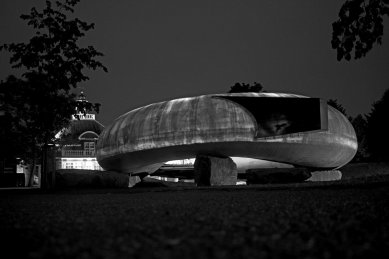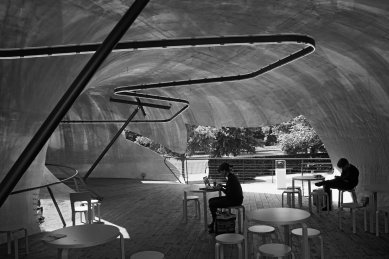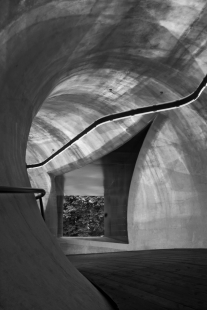
Chilean Bestiary - for the exhibition of Smiljan Radić in České Budějovice
At the end of April, Chilean architect Smiljan Radić will visit České Budějovice. In the past two years, this is already the second Chilean studio whose work visitors can view at the House of Art. Radić's exhibition titled Bestiary will provide a unique perspective not only on the contemporary Chilean architectural scene. The New York Times humorously describes the fifty-one-year-old Radić as an architectural “Rock Star.” Not in the sense of a famous rock star, but according to the architect's elemental approach to the materials used and the resulting form.
Chile is a country with a rich pre-Columbian history, but modern architecture began to develop here only in the free environment after the fall of Pinochet’s regime in 1990. One can sense South Slavic roots in Radić’s surname. His grandfather arrived in Chile in 1919 from the Croatian island of Brač. As an immigrant, he perceived his new homeland from the perspective of unlimited possibilities. In today’s generation, which was born in Chile, the feeling of being a refugee persists. The motif of a tent repeatedly occurs in Radić's buildings. Makeshift coverings with tarpaulin that we are accustomed to seeing among people who are always on the move. The textiles carried by nomads are weighed down with stones, which, in contrast, have been lying in place for thousands of years. This thrilling Chilean dilemma arouses global interest.
Smiljan Radić was born in 1965, studied architecture at the Pontifical Catholic University of Chile, and subsequently continued his studies at IUAV in Venice. After winning the Platiía Eleftería competition, he worked on the realization of a project in Greece. After a three-year journey, in 1995, he opened his own architectural studio in Santiago de Chile. In 2001, he received the Chilean "Colegio de Arquitectos" award for young architects under thirty-five, and subsequently earned the "Design Vanguard 2008" award from the American magazine Architectural Record and shortly afterwards became an honorary member of the American Institute of Architects in 2009. He has spent most of his professional career in Chile, but he lectures and exhibits worldwide. He often collaborates on projects with Chilean sculptor Marcela Correa, who is also his life partner.
Radić himself does not see himself as an architect, but rather as a builder who strives to understand the construction and not repeat the form. For him, the structure is more important than the resulting architecture. He enjoys working on small topics that allow him to collaborate closely with other professions directly on site. His plans are merely indicative, so that the workers are not intimidated and can refine them during the realization of the object.
He prefers slow work and draws from local tradition. However, he can adapt and is open to completely new solutions. He approaches assignments entirely differently than architects who yearn to deploy their monuments. He creates in close harmony with the landscape. The beautiful Chilean landscape leads him to respect it as much as possible and not to disrupt it too much with his interventions. His oversized buildings may initially seem cheap. Boulder architecture conveys a sense of primitiveness while simultaneously evoking eternity. Stones that have been smoothed by the elements for thousands of years help anchor the object in the landscape. On these solid foundations, however, he enjoys creating light textile roofs that give the impression that even the slightest breeze could move them to another place. In his approach, it is very common to combine elements of formally different origins. He enjoys lightly deceiving himself and creating illusions of weight and unexpected transparency.
Radić's Chilean buildings are always tied to the history of the place. In a thirteen-year-old example of a family house in the town of Nercón, the outer shell refers to the beginning of the last century when all local houses and churches had facades made of galvanized steel. With its ribbed texture made of electrolytic copper, it mimics the local geological specifics, namely the exposed slate layers.
Radić's first realization outside his native Chile was an exhibition at the 12th Venice Biennale in 2010, where he created an exhibit referencing the earthquake that shifted the Earth's axis and shortened the day. His contribution to the biennale took the form of a giant boulder, into which he carved a refuge from the destructive elements. Three years ago, he received a prestigious commission for a summer pavilion for the Serpentine Gallery in London, which prestigious newspapers described as “an alien egg that crashed into a Neolithic burial site.” Radić evoked in visitors to the London pavilion an illusion of something subconscious, while simultaneously disturbing them. The resulting object was both mysteriously archaic and, in the best sense of the word, romantically foolish.
To experience similar feelings, you can journey to the Austrian village of Krumbach, located five hundred kilometers from České Budějovice, where Radić collaborated on a project with local architect Bernardo Bader, who is renowned for his minimalism. You will immediately recognize Radić's interventions (a sculptural spout or an excessive birdhouse), which he attempted to translate the atmosphere of local rooms into a small stop with a view of the landscape.
The House of Art in České Budějovice will bring you the exhibition Bestiary during May, which will allow a glimpse into Radić's fantastical world through twenty models and twenty-eight drawings, into which he turns for inspiration for his real projects. Medieval bestiaries depicting imaginary animals. In Radić's case, there is, for example, the model “Castle of the Selfish Giant," based on Oscar Wilde's fairy tale The Selfish Giant (1888). Another exhibited model is “House for the Poem of the Right Angle,” which Radić designed for himself and his family based on a series of nineteen lithographs titled The Poem of the Right Angle by Le Corbusier (1955). For the object “Boy Hidden in the Egg,” Radić was inspired by the drawings of British painter David Hockney (1969) that accompany a set of six fairy tales by the Brothers Grimm (1812). Hockney managed to depict an absurd situation in several layers with a simple line.
These three examples demonstrate that for Radić, the hidden story and history are far more important than the object itself, something that is valued like saffron in today’s era of emptied minimalist boxes.
Chile is a country with a rich pre-Columbian history, but modern architecture began to develop here only in the free environment after the fall of Pinochet’s regime in 1990. One can sense South Slavic roots in Radić’s surname. His grandfather arrived in Chile in 1919 from the Croatian island of Brač. As an immigrant, he perceived his new homeland from the perspective of unlimited possibilities. In today’s generation, which was born in Chile, the feeling of being a refugee persists. The motif of a tent repeatedly occurs in Radić's buildings. Makeshift coverings with tarpaulin that we are accustomed to seeing among people who are always on the move. The textiles carried by nomads are weighed down with stones, which, in contrast, have been lying in place for thousands of years. This thrilling Chilean dilemma arouses global interest.
Smiljan Radić was born in 1965, studied architecture at the Pontifical Catholic University of Chile, and subsequently continued his studies at IUAV in Venice. After winning the Platiía Eleftería competition, he worked on the realization of a project in Greece. After a three-year journey, in 1995, he opened his own architectural studio in Santiago de Chile. In 2001, he received the Chilean "Colegio de Arquitectos" award for young architects under thirty-five, and subsequently earned the "Design Vanguard 2008" award from the American magazine Architectural Record and shortly afterwards became an honorary member of the American Institute of Architects in 2009. He has spent most of his professional career in Chile, but he lectures and exhibits worldwide. He often collaborates on projects with Chilean sculptor Marcela Correa, who is also his life partner.
Radić himself does not see himself as an architect, but rather as a builder who strives to understand the construction and not repeat the form. For him, the structure is more important than the resulting architecture. He enjoys working on small topics that allow him to collaborate closely with other professions directly on site. His plans are merely indicative, so that the workers are not intimidated and can refine them during the realization of the object.
He prefers slow work and draws from local tradition. However, he can adapt and is open to completely new solutions. He approaches assignments entirely differently than architects who yearn to deploy their monuments. He creates in close harmony with the landscape. The beautiful Chilean landscape leads him to respect it as much as possible and not to disrupt it too much with his interventions. His oversized buildings may initially seem cheap. Boulder architecture conveys a sense of primitiveness while simultaneously evoking eternity. Stones that have been smoothed by the elements for thousands of years help anchor the object in the landscape. On these solid foundations, however, he enjoys creating light textile roofs that give the impression that even the slightest breeze could move them to another place. In his approach, it is very common to combine elements of formally different origins. He enjoys lightly deceiving himself and creating illusions of weight and unexpected transparency.
Radić's Chilean buildings are always tied to the history of the place. In a thirteen-year-old example of a family house in the town of Nercón, the outer shell refers to the beginning of the last century when all local houses and churches had facades made of galvanized steel. With its ribbed texture made of electrolytic copper, it mimics the local geological specifics, namely the exposed slate layers.
Radić's first realization outside his native Chile was an exhibition at the 12th Venice Biennale in 2010, where he created an exhibit referencing the earthquake that shifted the Earth's axis and shortened the day. His contribution to the biennale took the form of a giant boulder, into which he carved a refuge from the destructive elements. Three years ago, he received a prestigious commission for a summer pavilion for the Serpentine Gallery in London, which prestigious newspapers described as “an alien egg that crashed into a Neolithic burial site.” Radić evoked in visitors to the London pavilion an illusion of something subconscious, while simultaneously disturbing them. The resulting object was both mysteriously archaic and, in the best sense of the word, romantically foolish.
To experience similar feelings, you can journey to the Austrian village of Krumbach, located five hundred kilometers from České Budějovice, where Radić collaborated on a project with local architect Bernardo Bader, who is renowned for his minimalism. You will immediately recognize Radić's interventions (a sculptural spout or an excessive birdhouse), which he attempted to translate the atmosphere of local rooms into a small stop with a view of the landscape.
The House of Art in České Budějovice will bring you the exhibition Bestiary during May, which will allow a glimpse into Radić's fantastical world through twenty models and twenty-eight drawings, into which he turns for inspiration for his real projects. Medieval bestiaries depicting imaginary animals. In Radić's case, there is, for example, the model “Castle of the Selfish Giant," based on Oscar Wilde's fairy tale The Selfish Giant (1888). Another exhibited model is “House for the Poem of the Right Angle,” which Radić designed for himself and his family based on a series of nineteen lithographs titled The Poem of the Right Angle by Le Corbusier (1955). For the object “Boy Hidden in the Egg,” Radić was inspired by the drawings of British painter David Hockney (1969) that accompany a set of six fairy tales by the Brothers Grimm (1812). Hockney managed to depict an absurd situation in several layers with a simple line.
These three examples demonstrate that for Radić, the hidden story and history are far more important than the object itself, something that is valued like saffron in today’s era of emptied minimalist boxes.
magazine Milk & Honey, April/May 2017, pp. 6-7
The English translation is powered by AI tool. Switch to Czech to view the original text source.





0 comments
add comment











